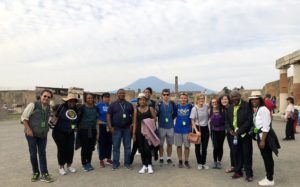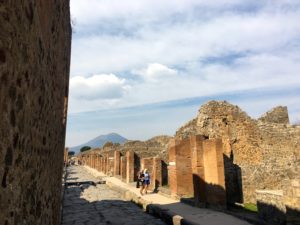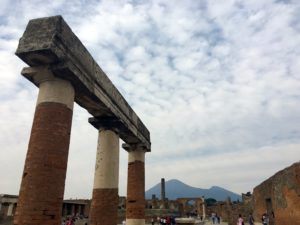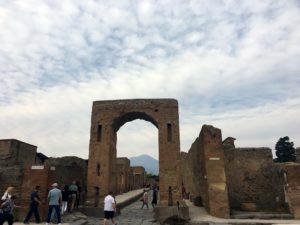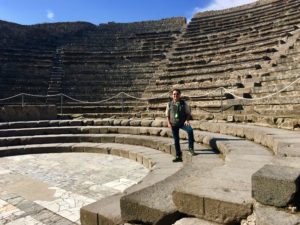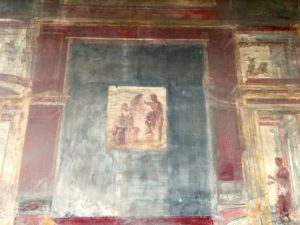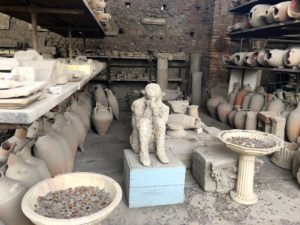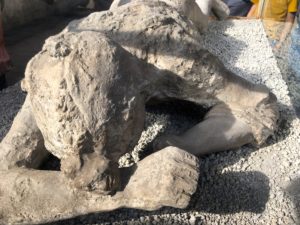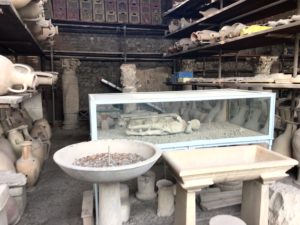Pompeii, the buried city
Pompeii was a town in the Italian region of Campania which was completely buried in volcanic ash following the eruption of nearby Mt. Vesuvius in 79 AD.
The area was originally settled in the Bronze Age on an escarpment on the mouth of the river Sarno. The site of Pompeii and the surrounding area offered the twin advantages of a favorable climate and rich volcanic soil which allowed for the blossoming of agricultural activity, particularly olives and grapes.
1st Century BCE Pompeii took part in the war that the towns of Campania initiated against Rome, but in 89 BC it was besieged by Sulla. The city was forced to surrender after the conquest of Nola, culminating in many of Sulla’s veterans being given land and property, while many of those who went against Rome were ousted from their homes. It became a Roman colony with the name of Colonia.
Pompeii became an important passage for goods that arrived by sea and had to be sent toward Rome or South of Rome along the nearby Appian Way.
The population of the town has been estimated at 11-12.000, with one third being slaves. Twice as many people again would have lived in the surrounding farms and villas. The coast of Campania was a favourite playground of Rome’s well-to-do and so many of the villas were particularly grand with panoramic sea-side views.
Even emperor Nero is thought to have had a villa near Pompeii and it is to be remembered that his wife Poppaea Sabina was a native of the town.
On the morning of August 24th, 79 (traditional date? check the recent excavation news !) a tremendous bang signaled that the magma that had been building over the last thousand years had finally burst through the crater of Vesuvius. Fire and smoke bellowed from the volcano. At this point, it may have seemed that the mountain was doing nothing more than offering a harmless pyrotechnic display but at midday an even bigger explosion blew off the entire cone of Vesuvius and a massive mushroom cloud of pumice particles rose 27 miles (43 km) into the sky. The power of the explosion has been calculated as 100,000 times greater than the nuclear bomb which devastated Hiroshima in 1945 CE. The ash that started to rain down on Pompeii was light in weight but the density was such that within minutes everything was covered in centimeters of it. People tried to flee the town or sought shelter where they could and those without shelter tried desperately to keep themselves above the shifting layers of volcanic material.
Then in the late afternoon another massive explosion rang the air, sending a layer of ash six miles higher than the previous cloud. When the ash fell it was as much heavier stones than in the first eruption and the volcanic material that smothered the town was by now metres thick. Buildings began to collapse under the accumulated weight; survivors huddled near walls and under stairs for greater protection, some hugging their loved ones or clasping their most precious possessions. Then at 11pm the huge cloud hanging above the volcano collapsed from its own weight and blasted the town in six devastating waves of super-heated ash and air which asphyxiated and literally baked the bodies of the entire population. Still the ash kept falling and relentlessly the once vibrant city was buried metres deep, to be lost and forgotten, wiped from the face of the Earth.
The largest surviving body of Pliny the Younger’s work is his Epistulae (Letters), a series of personal missives directed to his friends and associates. These letters are a unique testimony of Roman administrative history and everyday life in the 1st century AD. Especially noteworthy among the letters are two in which he describes the eruption of Mount Vesuvius in August 79, during which his uncle Pliny the Elder died (Epistulae VI.16, VI.20), and one in which he asks the Emperor for instructions regarding official policy concerning Christians (Epistulae X.96).
Pliny wrote the two letters describing the eruption of Mount Vesuvius approximately 25 years after the event, and both were sent in response to the request of his friend, the historian Tacitus who wanted to know more about Pliny the Elder’s death. The two letters have great historical value due to their accurate description of Vesuvius’ eruption; Pliny’s attention to detail in the letters about Vesuvius is so keen that modern volcanologists describe those types of eruptions as Plinian Eruptions.
Pompeii was finally re-discovered in 1755 CE when work on the construction of the Sarno Canal began.


